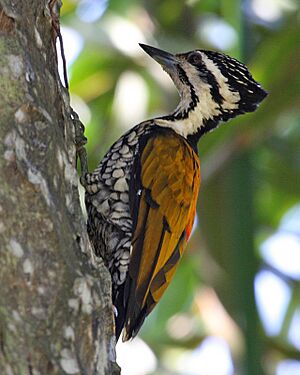Common flameback facts for kids
Quick facts for kids Common flameback |
|
|---|---|
 |
|
| Male in Singapore | |
 |
|
| Female in Singapore | |
| Conservation status | |
| Scientific classification | |
| Genus: |
Dinopium
|
| Species: |
javanense
|
The common flameback (Dinopium javanense) is a small woodpecker. It is also called the common goldenback. These birds are about 28–30 cm long. They have three toes, which is unusual for woodpeckers. You can find them across South and Southeast Asia.
Contents
About the Common Flameback
The common flameback belongs to the woodpecker family, called Picidae. It is closely related to other flameback species. These include the Himalayan flameback and the spot-throated flameback. It also has relatives like the black-rumped flameback and the red-backed flameback.
Types of Common Flamebacks
There are six different types, or subspecies, of the common flameback:
- Dinopium javanense javanense - Lives in southern Thailand, Sumatra, and western Java.
- Dinopium javanense malabaricum - Found in southwest India.
- Dinopium javanense intermedium - This is the largest type. It lives in Bangladesh, eastern Myanmar, and southern China.
- Dinopium javanense borneonense - Found in most of Borneo.
- Dinopium javanense raveni - Lives in northeast Borneo and nearby small islands.
- Dinopium javanense exsul - Found in eastern Java and Bali.
Where They Live
Common flamebacks are shy birds. You usually won't find them in cities. They prefer to live in different kinds of places. These include moist open forests, scrubs, and mangroves. They mostly live in low areas. But in India, they can be found in pine forests up to 1700 meters high.
Their home range covers much of Southeast Asia. This stretches from Western Ghats in India to the Indochinese peninsula. They also live on several of the Greater Sunda Islands.
What They Look Like
Male and female common flamebacks look a bit different. Males have a bright red crest on their head. Females have a black crest with white stripes. Both sexes have white stripes above their eyes and on their cheeks. Their throats are also white, with black stripes separating these white areas. Their undersides are spotted black and white.
You can tell them apart from other similar woodpeckers. The greater flameback is larger and has a different colored neck. The black-rumped flameback has a black rump, while the common flameback has a red rump. Their calls are also a good way to tell them apart. The common flameback has a loud, high-pitched call. It sounds like a series of "kow-kowp" rattles. This call is very similar to the greater flameback's call.
How They Behave
Sounds They Make
The common flameback is usually a quiet bird. Even though it can make many sounds, it doesn't often make noise. Unlike many woodpeckers, it rarely drums on wood. This is because it finds food in a different way. Sometimes, a male bird might softly tap his nest with his beak. This might be a way to show he's bothered by someone nearby.
Common flamebacks make different kinds of calls:
- "Wicka call": This call lasts about four seconds. One or both birds in a pair can make it. It has different types of notes.
- "Kow call": This is a single or double note.
- "Kowp call": This call is more complex than the "kow call." Birds often make it when they are taking off, flying, or landing. This suggests it might be an alarm call. It warns other birds about danger.
- "Rattle call": This call usually follows the "kowp call." It's a fast series of many notes. It can last from less than a second to over two seconds.
What They Eat and How They Find Food
Common flamebacks have many ways to find food. But they usually don't peck wood much. Their beaks are quite small. This means they are better at picking up insects or poking for them. This way of finding food makes no noise. They often stay still and quiet for a long time. Then, they quickly lunge and peck at insects.
They are strict insectivores, meaning they only eat insects. Their main food is ants, which are very common. But they also catch slow-flying insects in the air. They also pick other bugs off trees. Their special three-toed feet help them hop quickly and easily. When they hop, two toes point forward and one points back. When they rest, all three toes point forward.
Males and females often look for food on different trees. But they stay in touch by calling and looking at each other. If one bird lands near another, they move apart. They might also peek at each other or raise their crests. Both males and females do this.
Raising Their Young
We don't know a lot about how common flamebacks reproduce. Some people say there are no special displays when they mate. The male might just raise his crest. Others say there is a short mating display. This includes both birds raising their crests. They might also bow their heads or swing them. Males might even feed the females as part of courtship.
They make their nests in holes. These holes are usually in fruit trees, coconut palms, or old tree stumps. A female usually lays 2 or 3 eggs at a time.


